Just as Mother Nature transforms barren landscapes into vibrant ecosystems, you can revolutionize your living spaces with strategic plant placement and creative displays. You’ll discover how to maximize vertical space, repurpose everyday items, and create stunning focal points that reflect your personal style. From living walls that command attention to intimate corner gardens that whisper tranquility, these nine decoration ideas will help you cultivate an indoor sanctuary that’s both functional and inspiring. Let’s explore how each room in your home can flourish with these innovative approaches.
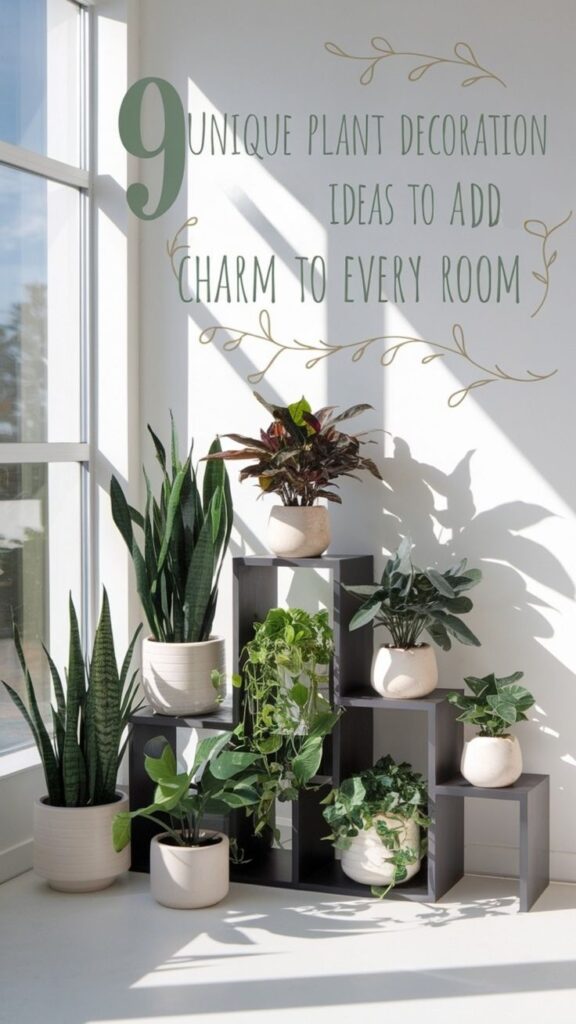
Contents
- 1 Living Plant Walls That Make a Statement
- 2 Suspended Macramé Gardens for Vertical Appeal
- 3 Geometric Terrariums as Artistic Centerpieces
- 4 Repurposed Vintage Finds as Plant Displays
- 5 Floating Window Shelves for Sun-Loving Plants
- 6 Plant-Filled Room Dividers and Partitions
- 7 Mini Indoor Herb Gardens With Style
- 8 Bathroom Oasis With Tropical Varieties
- 9 Creative Corner Plant Arrangements
Living Plant Walls That Make a Statement
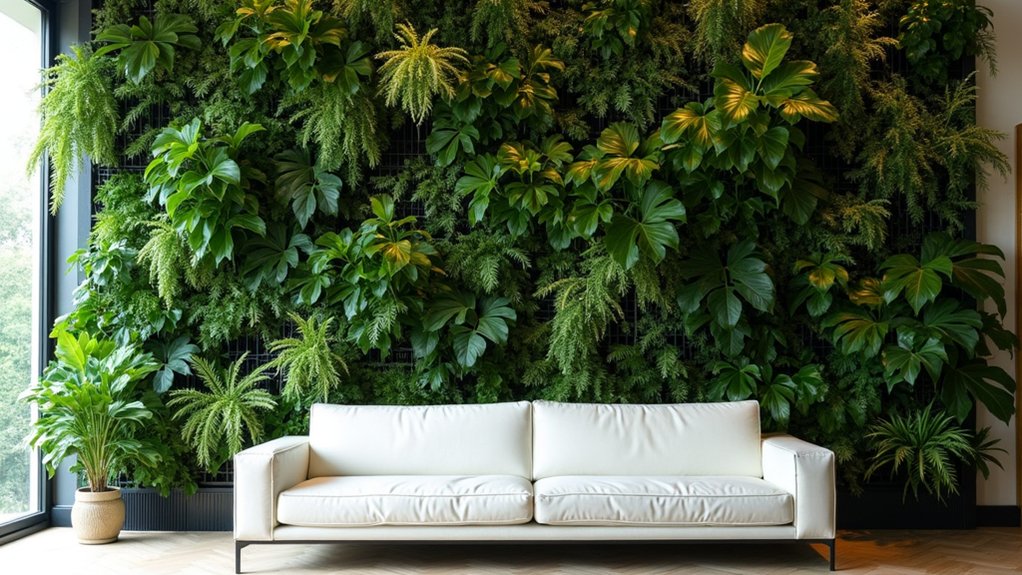
Living plant walls transform vertical spaces into lush, green tapestries that serve as stunning architectural elements. These installations combine multiple plant varieties arranged in modular panels or pocket systems, creating a dynamic living artwork that can span entire walls.
The visual impact ranges from subtle monochromatic designs using single species to dramatic compositions mixing textures, colors, and trailing plants that add depth and movement to the space.
- Light: Bright, indirect light; avoid direct afternoon sun that can scorch leaves
- Water: Regular moisture through irrigation system or manual watering; soil should remain consistently moist but not waterlogged
- Soil: Well-draining potting mix specifically formulated for vertical gardens
- Humidity: 40-60% relative humidity
- Temperature: 65-80°F (18-27°C)
- Air circulation: Good airflow to prevent fungal issues
- Support system: Strong mounting structure capable of supporting wet soil weight
Regular maintenance is crucial for a thriving living wall. Pruning dead or yellowing foliage, checking irrigation systems weekly, monitoring plant health for pest infestations, and fertilizing quarterly with balanced, water-soluble nutrients keep the wall vibrant.
Replacing failing plants promptly prevents gaps from developing, while periodic cleaning of leaves removes dust and maintains optimal photosynthesis. Seasonal evaluation of plant placement ensures each specimen continues to thrive in its position, with adjustments made for changing light conditions or growth patterns.
Suspended Macramé Gardens for Vertical Appeal
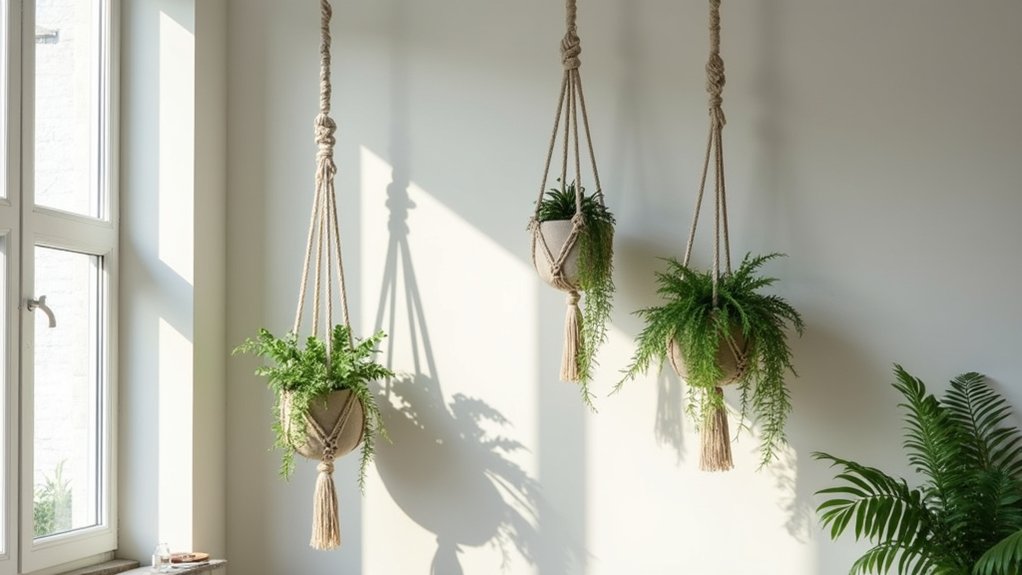
Suspended macramé gardens transform indoor spaces by creating eye-catching vertical displays of hanging plants in handcrafted rope holders. These decorative plant arrangements combine the artistic elements of knotted macramé with carefully selected trailing plants, adding depth and dimension to rooms while maximizing limited floor space.
The woven holders can range from simple designs to intricate patterns, often featuring multiple tiers or asymmetrical arrangements that allow plants to cascade naturally.
- Light: Bright, indirect light is optimal; avoid direct sunlight which can fade macramé fibers
- Water: Allow soil to dry slightly between waterings; ensure proper drainage to prevent rope deterioration
- Soil: Well-draining potting mix with added perlite or orchid bark
- Temperature: 65-80°F (18-27°C)
- Humidity: Moderate to high, depending on plant selection
- Weight capacity: Choose appropriate anchor points to support fully watered plants
Regular maintenance of suspended macramé gardens involves checking the integrity of knots and hanging points monthly, rotating plants quarterly for even growth, and cleaning the macramé fibers with a gentle brush to remove dust accumulation.
Trim yellowing or dead foliage promptly to maintain aesthetics and prevent moisture-related issues, and periodically adjust plant positioning within the holders to prevent stems from becoming tangled or stressed.
During seasonal care, evaluate if plants need repotting or if macramé cords require tightening or replacement due to natural stretching over time.
Geometric Terrariums as Artistic Centerpieces
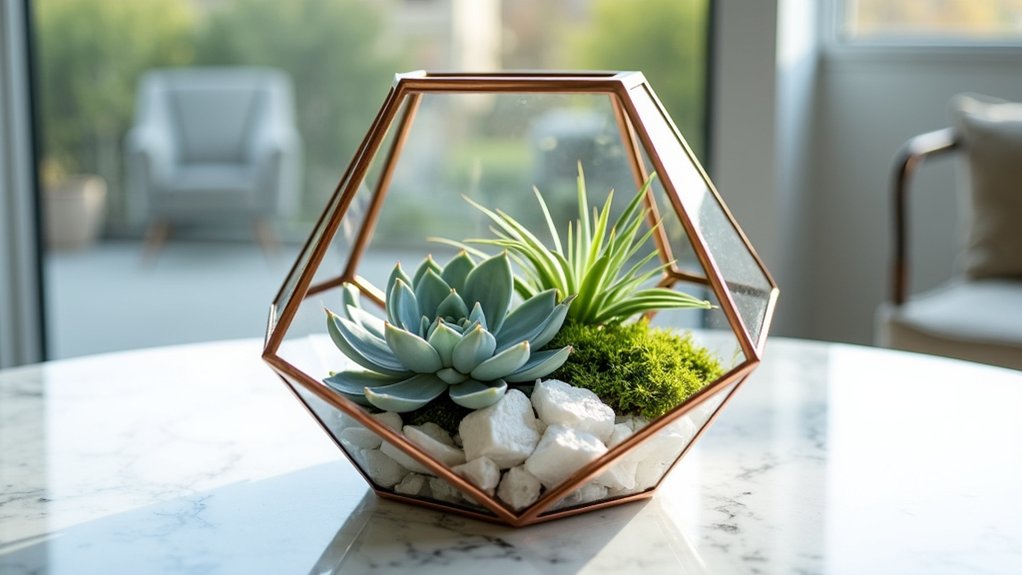
Geometric terrariums serve as striking modern centerpieces that combine glass architecture with living art.
These angular, clear containers, often featuring clean lines and metallic trim, showcase miniature plant ecosystems while doubling as sculptural elements.
Whether hanging or tabletop, these terrariums create a contemporary aesthetic that works particularly well with succulents, air plants, and small tropical specimens arranged in visually balanced compositions.
Growing Conditions:
- Light: Bright, indirect sunlight; avoid direct sun which can create greenhouse effect
- Humidity: 40-60% for tropical plants; lower for succulents
- Temperature: 65-80°F (18-27°C)
- Soil: Well-draining succulent mix for desert plants; orchid mix for tropical varieties
- Container: Must have drainage holes or layers of activated charcoal and gravel
- Ventilation: Periodic opening to prevent excess moisture buildup
Regular maintenance ensures these living displays remain pristine and healthy.
Remove any dead leaves or flower heads promptly to prevent mold growth.
Clean glass surfaces monthly using a soft cloth to maintain visibility and aesthetic appeal.
Rotate the terrarium quarterly to ensure even growth, and trim plants when they outgrow their designated space.
If condensation appears on glass walls for more than a day, increase ventilation by leaving the terrarium open for several hours.
Repurposed Vintage Finds as Plant Displays
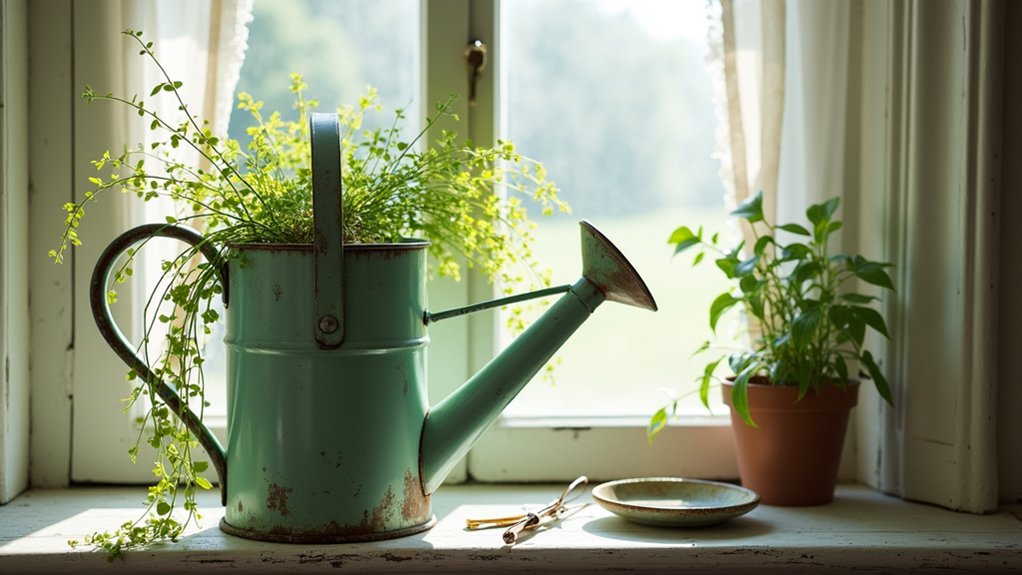
Repurposed vintage finds add character and charm to indoor plant displays while giving new life to antique items. Old metal watering cans, rustic wooden crates, retro kitchen containers, vintage suitcases, and weathered ladders can be transformed into unique plant holders that create visual interest and conversation pieces.
These unconventional displays work particularly well with trailing plants, succulents, and small potted specimens, allowing you to combine classic aesthetics with living greenery.
Display Considerations:
- Ensure proper drainage by adding holes to non-porous containers
- Place protective saucers or liners inside delicate vintage items
- Position displays away from direct water exposure to prevent rust
- Select container size appropriate for plant root systems
- Choose vintage items with stable bases to prevent tipping
- Consider weight capacity when mounting wall displays
When using vintage items as planters, regular inspection is crucial to maintain both the plants and the antique containers.
Check for signs of water damage, rust, or deterioration that could affect plant health or compromise the vintage piece. Clean containers periodically with appropriate materials that won’t damage the patina or finish.
Remove any accumulated salts or mineral deposits around the container edges, and periodically assess if plants need to be moved to larger containers as they grow, ensuring the vintage display remains both functional and aesthetically pleasing.
Floating Window Shelves for Sun-Loving Plants
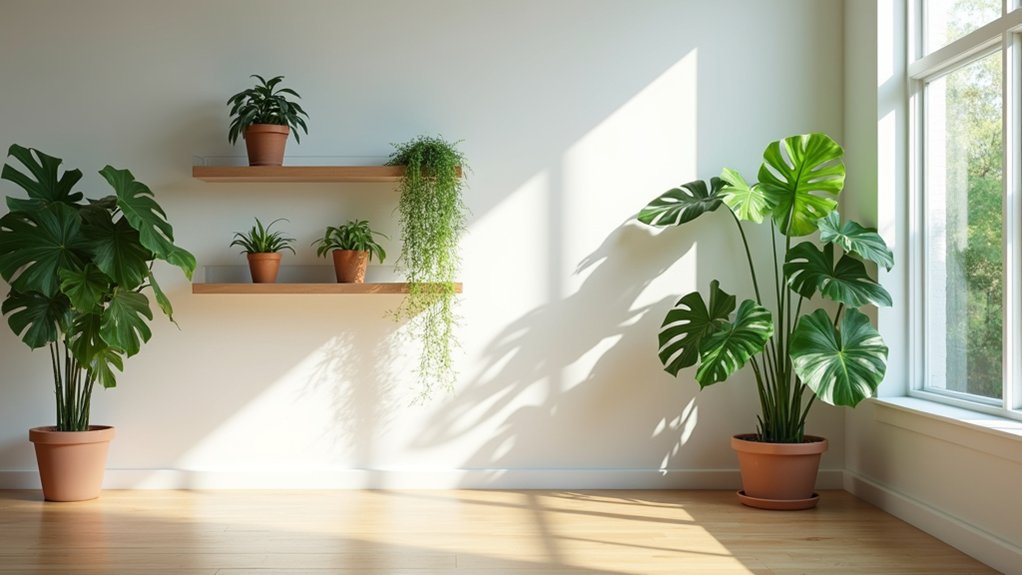
Floating window shelves offer an elegant solution for displaying sun-loving plants while maximizing natural light exposure. These sleek, minimalist shelves mount directly to window frames or adjacent walls, creating the illusion that plants are suspended in mid-air.
Typically constructed from clear acrylic, glass, or sturdy wood materials, these shelves can accommodate various pot sizes and can be arranged in single rows or tiered configurations to create a striking visual display.
Growing Conditions:
- Select window locations that receive 6-8 hours of direct sunlight daily
- Choose south or west-facing windows for optimal light exposure
- Ensure shelves are mounted securely to support plant weight
- Maintain room temperature between 65-80°F (18-27°C)
- Keep humidity levels at 40-60% for most indoor plants
- Allow 4-6 inches between plants for proper air circulation
Regular maintenance of floating window shelves involves periodic cleaning of shelf surfaces to prevent dust accumulation and water spots.
Rotate plants quarterly to ensure even growth, and inspect shelf mounting hardware monthly for stability.
Consider installing adjustable brackets to modify shelf angles based on seasonal sun patterns, and use drip trays or moisture-resistant materials to protect shelving from water damage.
During extreme weather, temporarily relocate plants if window temperatures fluctuate drastically.
Plant-Filled Room Dividers and Partitions
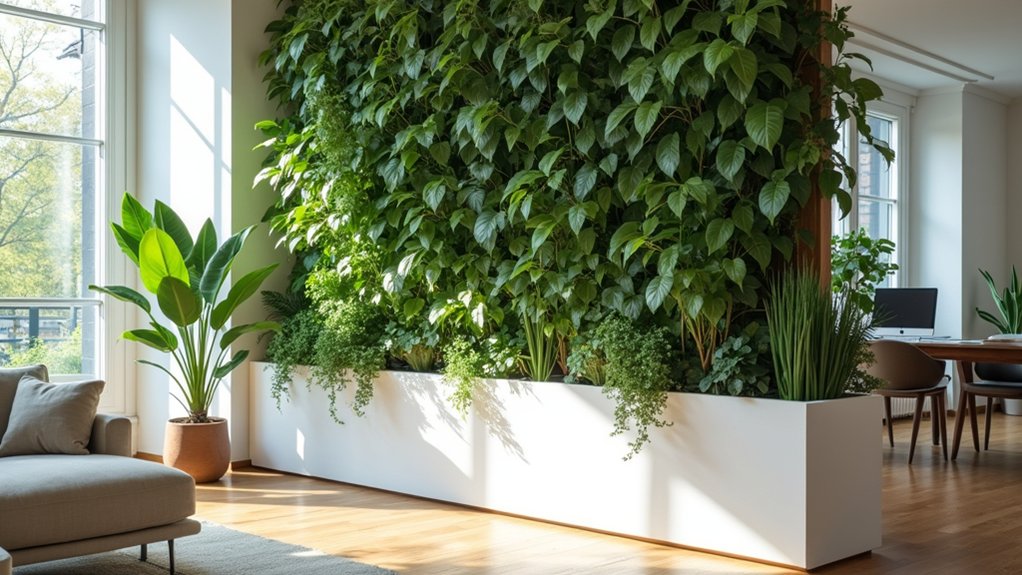
Plant-filled room dividers and partitions combine functionality with natural beauty, creating living walls that separate spaces while adding vibrant greenery to any interior.
These vertical garden structures can range from freestanding screens with built-in planters to modular systems mounted between floor and ceiling, featuring a variety of plants arranged in patterns or cascading designs.
Common choices include trailing plants like pothos, ferns, and philodendrons, which create lush, flowing effects, while upright plants like snake plants and ZZ plants provide structural elements.
Growing Conditions:
- Indirect light is ideal for most indoor partition plants, though intensity needs vary by species
- Maintain ambient room temperature between 65-80°F (18-27°C)
- Humidity levels should stay above 40% for optimal growth
- Well-draining potting mix with adequate aeration
- Water when top 1-2 inches of soil feels dry
- Monthly feeding during growing season with balanced liquid fertilizer
Regular maintenance ensures the longevity and aesthetic appeal of plant-filled room dividers.
Rotate the structure periodically to ensure even growth on all sides, and trim overgrown sections to maintain the desired shape.
Dust leaves monthly with a damp cloth to maximize photosynthesis and prevent pest issues.
Check the support structure regularly to ensure it remains stable and capable of supporting the increasing plant weight, and adjust ties or supports as plants grow to prevent damage to stems and maintain the intended design.
Mini Indoor Herb Gardens With Style
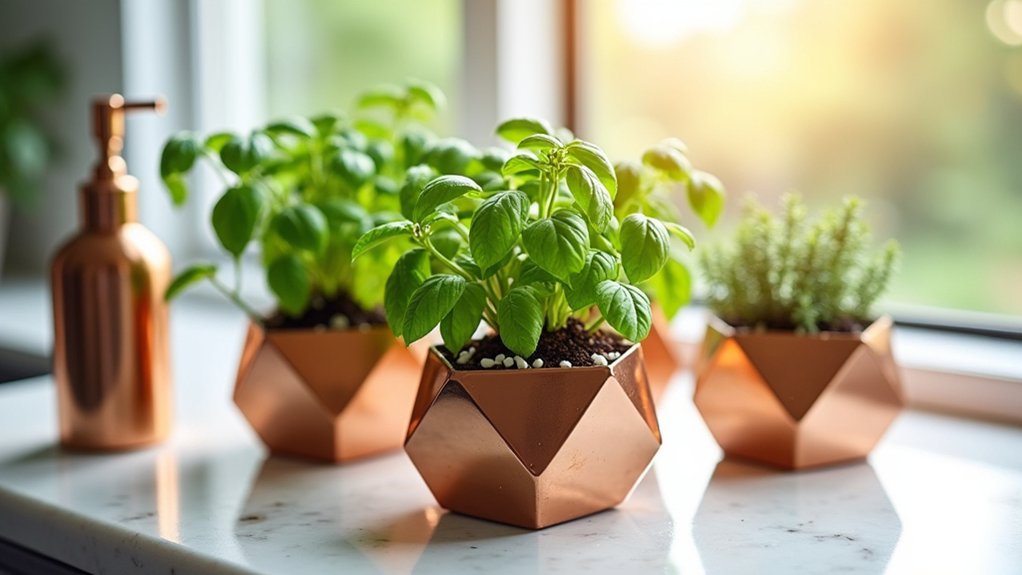
Mini indoor herb gardens combine functionality with decorative appeal, featuring compact arrangements of culinary herbs in stylish containers. These gardens typically include popular cooking herbs like basil, thyme, rosemary, and mint, arranged in coordinated pots or a single divided planter.
Modern designs incorporate elements like copper tags, geometric containers, or tiered displays, making them both a practical kitchen resource and an attractive decor piece.
- Light: 6-8 hours of direct sunlight daily, preferably near a south-facing window
- Water: Consistent moisture with well-draining soil; water when top inch feels dry
- Soil: Well-aerated potting mix specifically formulated for herbs
- Temperature: 65-70°F (18-21°C)
- Container: Pots with drainage holes, at least 6 inches deep
- Spacing: 4-6 inches between different herbs
- Humidity: Moderate, around 40-60%
Regular pruning encourages bushier growth and prevents herbs from becoming leggy or flowering prematurely.
Rotate containers weekly to ensure even growth, and fertilize with a balanced, water-soluble fertilizer every 4-6 weeks during the growing season.
Remove any yellowing or dead leaves promptly to prevent disease spread, and harvest herbs regularly to promote continuous growth.
When trimming, never remove more than one-third of the plant at once to maintain vitality.
Bathroom Oasis With Tropical Varieties
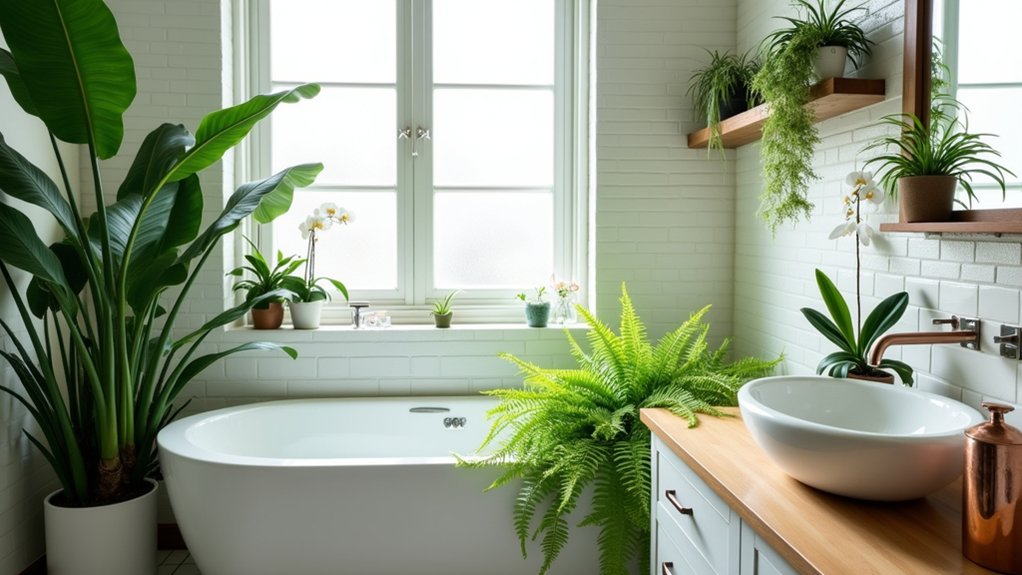
Transform your bathroom into a lush, spa-like retreat by incorporating tropical plants that thrive in humid environments. Large-leafed specimens like bird of paradise, orchids, and peace lilies create a dramatic focal point while smaller varieties like ferns and air plants can cascade from shelves or hang near windows.
The combination of glossy foliage and varied leaf textures adds depth and creates an immersive jungle atmosphere that complements modern bathroom fixtures.
- Light: Bright, indirect light; most tropical bathroom plants can tolerate moderate light conditions
- Water: Regular watering schedule, maintaining consistently moist but not waterlogged soil
- Humidity: 60-80% relative humidity; naturally achieved in bathroom environments
- Temperature: Warm environment between 65-80°F (18-27°C)
- Soil: Well-draining potting mix rich in organic matter
- Container: Pots with adequate drainage holes to prevent root rot
Regular grooming is essential for maintaining healthy tropical bathroom plants. Remove any yellowed or damaged leaves promptly to prevent disease spread and encourage new growth.
Dust leaves monthly with a damp cloth to maintain their glossy appearance and ensure proper photosynthesis. Rotate plants quarterly to promote even growth, and inspect regularly for common pests like spider mites and scale insects, which can be particularly problematic in warm, humid environments.
Supplement natural bathroom humidity by grouping plants together and using pebble trays during drier seasons.
Creative Corner Plant Arrangements

Creative corner plant arrangements transform unused corner spaces into eye-catching focal points by combining plants of varying heights, textures, and colors.
These arrangements typically feature a tall statement plant as a backdrop, medium-sized plants at mid-level, and trailing or compact plants at the base, creating a layered, dimensional display. Plant stands, shelves, or decorative containers at different elevations help achieve this cascading effect while maximizing vertical space.
- Light: Corners often receive indirect light; select plants according to the corner’s specific light conditions (north-facing corners need low-light plants, while south-facing corners can support sun-loving varieties)
- Water: Group plants with similar watering needs together to prevent over or under-watering
- Soil: Use well-draining potting mix appropriate for each plant type
- Space: Allow 2-3 inches between plants for proper air circulation
- Temperature: Maintain consistent room temperature between 65-80°F (18-27°C)
- Humidity: Group plants together to create a microclimate with increased humidity
Regular maintenance of corner arrangements involves rotating plants quarterly for even growth, pruning to maintain desired shapes, and cleaning leaves to maximize light absorption.
Monitor plant spacing as they grow to prevent overcrowding, and reassess the arrangement seasonally to ensure all plants continue receiving adequate light as sun patterns change throughout the year.
Replace struggling plants promptly to maintain the arrangement’s visual appeal.
